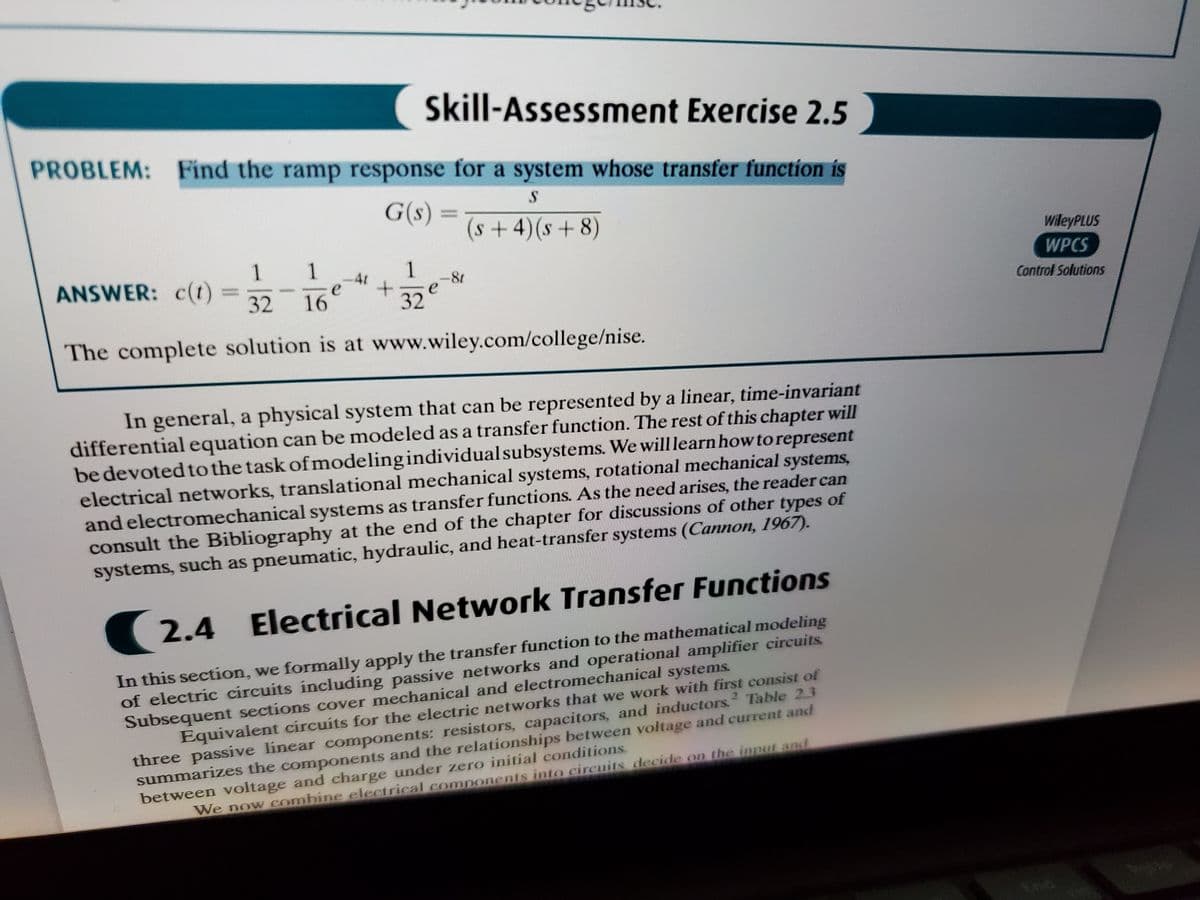G(s) : %3D WileyPLUS (s+4)(s+ 8) WPCS
Introductory Circuit Analysis (13th Edition)
13th Edition
ISBN:9780133923605
Author:Robert L. Boylestad
Publisher:Robert L. Boylestad
Chapter1: Introduction
Section: Chapter Questions
Problem 1P: Visit your local library (at school or home) and describe the extent to which it provides literature...
Related questions
Question
Find the step response instead of ramp response and graph the step response

Transcribed Image Text:Skill-Assessment Exercise 2.5
PROBLEM: Find the ramp response for a system whose transfer function is
G(s) =
(s+4)(s+ 8)
wileyPLUS
1.
ANSWER: c(t)
1
1
4r
e
16
WPCS
32
32
Control Solutions
The complete solution is at www.wiley.com/college/nise.
In general, a physical system that can be represented by a linear, time-invariant
differentialequation can be modeled as a transfer function. The rest of this chapter will
be devoted tothe task of modeling individualsubsystems. We will learn how torepresent
electrical networks, translational mechanical systems, rotational mechanical systems,
and electromechanical systems as transfer functions. As the need arises, the reader can
consult the Bibliography at the end of the chapter for discussions of other types of
systems, such as pneumatic, hydraulic, and heat-transfer systems (Cannon, 1967).
2.4
Electrical Network Transfer Functions
In this section, we formally apply the transfer function to the mathematical modeling
of electric circuits including passive networks and operational amplifier circuits
Subsequent sections cover mechanical and electromechanical systems.
Equivalent circuits for the electric networks that we work with first consist of
three passive linear components: resistors, capacitors, and inductors. Table 2.3
summarizes the components and the relationships between voltage and current and
between voltage and charge under zero initial conditions.
2.
We now combine electrical components into cireuits decide on the innut and
End
Expert Solution
This question has been solved!
Explore an expertly crafted, step-by-step solution for a thorough understanding of key concepts.
This is a popular solution!
Trending now
This is a popular solution!
Step by step
Solved in 6 steps with 1 images

Knowledge Booster
Learn more about
Need a deep-dive on the concept behind this application? Look no further. Learn more about this topic, electrical-engineering and related others by exploring similar questions and additional content below.Recommended textbooks for you

Introductory Circuit Analysis (13th Edition)
Electrical Engineering
ISBN:
9780133923605
Author:
Robert L. Boylestad
Publisher:
PEARSON

Delmar's Standard Textbook Of Electricity
Electrical Engineering
ISBN:
9781337900348
Author:
Stephen L. Herman
Publisher:
Cengage Learning

Programmable Logic Controllers
Electrical Engineering
ISBN:
9780073373843
Author:
Frank D. Petruzella
Publisher:
McGraw-Hill Education

Introductory Circuit Analysis (13th Edition)
Electrical Engineering
ISBN:
9780133923605
Author:
Robert L. Boylestad
Publisher:
PEARSON

Delmar's Standard Textbook Of Electricity
Electrical Engineering
ISBN:
9781337900348
Author:
Stephen L. Herman
Publisher:
Cengage Learning

Programmable Logic Controllers
Electrical Engineering
ISBN:
9780073373843
Author:
Frank D. Petruzella
Publisher:
McGraw-Hill Education

Fundamentals of Electric Circuits
Electrical Engineering
ISBN:
9780078028229
Author:
Charles K Alexander, Matthew Sadiku
Publisher:
McGraw-Hill Education

Electric Circuits. (11th Edition)
Electrical Engineering
ISBN:
9780134746968
Author:
James W. Nilsson, Susan Riedel
Publisher:
PEARSON

Engineering Electromagnetics
Electrical Engineering
ISBN:
9780078028151
Author:
Hayt, William H. (william Hart), Jr, BUCK, John A.
Publisher:
Mcgraw-hill Education,